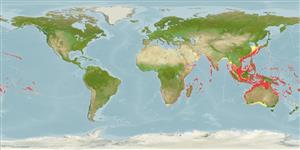Actinoptérygiens (poissons à nageoires rayonnées) >
Perciformes (Perch-likes) >
Carangidae (Jacks and pompanos) > Caranginae
Etymology: Caranx: French, carangue, the name of a Caribbean fish; 1836 (Ref. 45335).
Environnement / Climat / Gamme
Écologie
; marin; saumâtre récifal; profondeur 10 - 188 m (Ref. 58302). Tropical; 26°C - 29°C, preferred 27°C (Ref. 107945); 35°N - 37°S, 19°E - 129°W
Indo-Pacific: Red Sea and east coast of Africa to the Hawaiian and Marquesan islands, north to southern Japan (Ref. 559) and the Ogasawara Islands, south to northern Australia. Hybrid with Caranx melampygus found in Hawaii (Ref. 58422).
Length at first maturity / Taille / Poids / Âge
Maturity: Lm 60.0 range ? - ? cm
Max length : 170 cm TL mâle / non sexé; (Ref. 9710); common length : 100.0 cm TL mâle / non sexé; (Ref. 5213); poids max. publié: 80.0 kg (Ref. 4795)
Épines dorsales (Total): 9; Rayons mous dorsaux (Total): 17-22; Épines anales 3; Rayons mous anaux: 15 - 17.
Pelagic over sand and rock (Ref. 58302). Adults occur singly and inhabit clear lagoon and seaward reefs (Ref. 9710). They feed on crustaceans (like crabs and spiny lobsters) and fishes at night (Ref. 4887). Large individuals may be ciguatoxic. The largest trevally, reaching 1.7 m in length and a weight of over 60 kg (Ref. 48635). Spawning occurs on shallow seaward reefs and offshore banks (Ref. 37816). Juveniles are found in estuaries. Sold mostly fresh and dried salted.
Life cycle and mating behavior
Maturité | Reproduction | Frai | Œufs | Fécondité | Larves
Paxton, J.R., D.F. Hoese, G.R. Allen and J.E. Hanley, 1989. Pisces. Petromyzontidae to Carangidae. Zoological Catalogue of Australia, Vol. 7. Australian Government Publishing Service, Canberra, 665 p. (Ref. 7300)
Statut dans la liste rouge de l'IUCN (Ref. 115185)
CITES (Ref. 94142)
Not Evaluated
Menace pour l'homme
Reports of ciguatera poisoning (Ref. 9710)
Utilisations par l'homme
Pêcheries: commercial; Aquaculture: commercial; pêche sportive: oui; Aquarium: Aquariums publics
Outils
Articles particuliers
Télécharger en XML
Sources Internet
